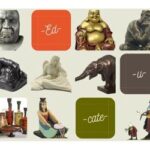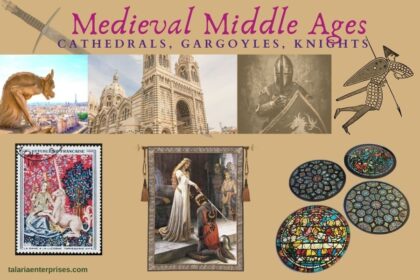
There are so many iconic Greek Roman Female Statues in museums around the world. Here we showcase a selection of original statues that are frequently reproduced as museum replicas and sold in the reproduction art market. These items have been customer favorites for 20 years.
We look at famous originals in our article. At the bottom, we offer replicas for sale.
Ancient Greece and Rome

Artemis Diana Daughter of Zeus
Strong willed and powerful Diana (Greek name Artemis) was the goddess of the hunt and of the moon with deadly arrows. She was the daughter of Zeus and Leto, twin sister of Apollo. In the Battle of the Giants, she killed the Giant Gration with the help of Heracles (Heracles). One famous story said that the twins shot all of Niobe’s fourteen children dead with their arrows to punish her slight to Leto. Remained unmarried, Artemis was also the protectress of children, always accompanied by deer and her beloved animals.

Aphrodite Aphrodite was the symbol of female beauty and Goddess of Love, identified in Rome with Venus. Although Homer describes Aphrodite as the daughter of Zeus and Dion, the more popular view was that she was conceived in the foam of the ocean from the seed of Uranus. Dropped there when he was castrated, her name meaning “foam-born”. Aphrodite was married to Hephaestus, but she loved Ares and she was known for her many love affairs, notably with Adonis and Anchises. Aphrodite the most beautiful woman in the world, inspired lust in all the humans and other creatures of the planet. No one could escape the traps that she set to amuse herself with the doings of love-crazed men and women. The passion which she planted in the human soul was the force that propelled fertilization and reproduction. Her symbols were the laurel, the pomegranate, the dove, the swan, the hare and the ram, all of them connected with physical love and reproduction.

Athena Athena was the Greek Goddess of wisdom and women’s crafts. She was also a defender against evil and a warrior Goddess par excellence. She was the daughter of Zeus and Metis. When Metis became pregnant, Gaia and Uranus told Zeus that after giving birth to a daughter, she would then have a son by Zeus who would later dethrone him. On Gaia’s advice, Zeus swallowed Metis. When the time came for the child to be born, Zeus was afflicted with a dreadful headache and sought the help of Hephaestus who split his skull with a bronze axe to relieve the pain. A girl in full armour sprang forth from his head: It was Athena. Athena’s attributes were the spear, the helmet and the Aegis (a goat-skin shield). She attached the Gorgon’s head which Perseus had given her to her shield, and this turned to stone every living thing that looked at it.
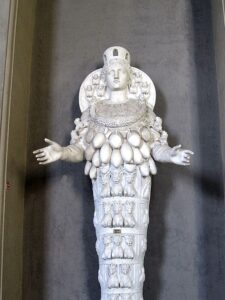
Diana of Ephesus
Diana was the daughter of Jupiter, the Chief God and the twin sister of Apollo. Her mother, Latona, was one of Jupiter’s paramours. When Diana was born her mother bore her painlessly, and then Diana helped her mother deliver Apollo, thus making Diana the Patroness of Childbirth. As a child Jupiter asked Diana what she like to have as gifts. She replied that she wanted eternal virginity (in the sense of always being true to her own nature), as many names as Apollo, a bow and arrow like Apollo’s, the office of bringing light (providing guidance to others), a saffron tunic with a red hem, and nine nymphs as her maidens.

This classicizing sculpture of Aphrodite/ Venus de Milo from the second half of the second century BC illustrates new hellenistic influences demonstrated by a higher waist, a twisting S-spiral throughout her body and low slung drapery. This is one of the most widely respected and reproduced of all ancient Greek works and adds loveliness to any setting.
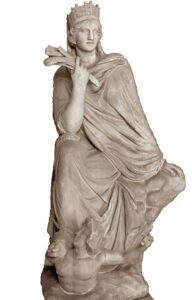
Fortuna (Tyche) Roman Goddess of Luck The Roman goddess Fortuna (Greek goddess Tyche) is the goddess of luck — hopefully of good luck. She stands holding a large cornucopia from which spills forth an abundance of coins. We hope the coins represent good fortune for us. But her blindfolded eyes suggest that luck is capricious and ever changing. Modern depictions of the Blind Justice Lady embraced by lawyers and judges borrow this symbolism.

Winged Nike The Nike of Samothrace was found on the island of Samothrace, in the Aegean Sea, Greece, in 1863 by a French expedition. Nike is the goddess who personified triumph and victory in Greek Mythology.
We look at famous originals in our article. At the bottom, we offer replicas for sale.

Athena Minerva Giustiniani Bust with Helmet Athena–as goddess of wisdom, skills and warfare–was one of the twelve Olympians. Here she is depicted wearing her traditional helmet. The statue is known as the Athena (Minerva) Giustiniani, a type of statue where she is wearing her warrior helmet and a cloak.

Hecate Goddess originally derived from the Egyptian midwife, Goddess Hekat. In Greece, Hecate was one of the many names for the original feminine trinity ruling the Heaven, Earth and Underworld.
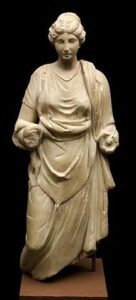
Hygeia was the goddess of health. Her brothers– Machaon, Panacea and Podalirius–were highly skilled in medicine and healing. Hygeia was one of the daughters of Asklepios, the Greco-Roman god of medicine and healing. Hygeia was worshipped as the goddess of good health or cleanliness. Her name is where we get the word hygiene.
Goddesses in the Garden
Three Graces These three personifications of gracefulness at the center back of this photo were the constant attendants of Aphrodite, the goddess of love. Here they are surrounded by a lush garden backdrop appearing to whisper in private amidst the foliage. Sculpted by the foremost Neoclassical sculptor in Europe, Antonio Canova in 1814, this sculpture exemplifies a common theme in art from this period–a revival of mythological themes and classical ideals from Greco-Roman antiquity.
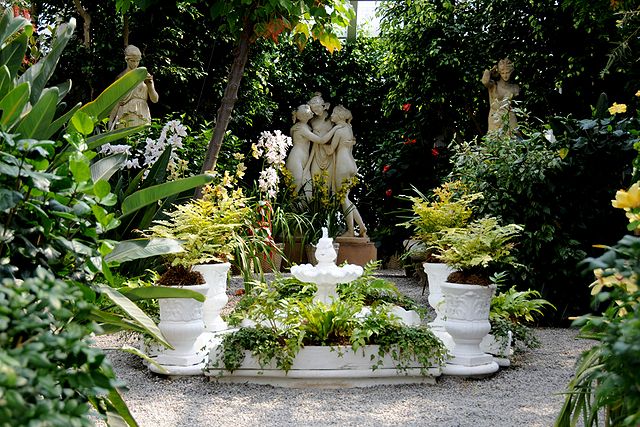

Here is a partial collection of our Greek and Roman statues available for sale in our online store. For more selection, visit Museumize.com Greek Roman Classical Collection
